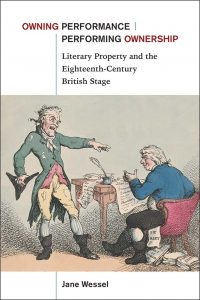Q&A with Author Jane Wessel about "Owning Performance | Performing Ownership"

This guest author post is a Q&A with Jane Wessel, author of Owning Performance | Performing Ownership , from the University of Michigan Press. This book is available in hardcover and ebook.
What surprised you the most while conducting your research for the book?
At the earliest stages of my research, when I was still working on my dissertation, I was surprised to discover I was actually working on a project about literary property. I had set out to write about eighteenth-century actor-playwrights. But as I researched the careers of Charles Macklin, Samuel Foote, Elizabeth Inchbald, and others, I was struck by just how preoccupied they were with maintaining control over the performance of their plays. It was fascinating to see these figures develop their own extra-legal strategies for protecting their works, especially because they were up against two property regimes that did not work in playwrights’ favor. First, the world’s first Copyright Act (1710) controlled only the reproduction of printed books and offered no protection to the medium of performance, the most valuable and profitable mode of publication for playwrights. Once authors printed their works, any theater could buy a copy and reperform it without paying the author and without the author’s permission. Playwrights were operating as freelancers within a theatrical duopoly: for most of the century, there were only two patent theaters that were allowed to stage legitimate drama. As a result of their vulnerable position within this competitive marketplace, they were at the mercy of theater managers. In spite of these hurdles, some playwrights managed to gain a reasonable degree of control over the performance of their works and began to shift the discourse around authors’ rights.
One of my favorite discoveries came as I was working in the York Minster Library with the Yorkshire theater manager Tate Wilkinson’s playbills. Early in his career, Wilkinson had regularly reperformed unprinted plays without asking the authors’ permission. He even advertised his thefts on his playbills and promised to perform the works “in the manner” of the original actors. But within a few decades, he began asking these same playwrights for permission to perform their works, and on a few truly exceptional playbills, he even communicated this permission to his audiences, calling the plays “private property.” This shift illustrates just how much playwrights were able to change the discourse surrounding dramatic literary property and create new norms.
Playbill for September 30, 1772, performance of The Fashionable Lover and Love à la Mode in Leeds. “A Collection of Playbills for Theatres Mainly in Yorkshire, 1772–75.” York Minster Library, York. Reproduced by permission of the Chapter of York.
What are some of the ways playwrights tried to control their intellectual property in the 18th century?
Playwrights could copyright the print publication of their plays, but they had no legal rights over performance. Some did embrace the opportunity to hold a print copyright. But in many cases, playwrights would keep their plays out of print to make it more difficult for rival theaters to obtain a copy of the work and perform it without their permission. Yet, if an unprinted play was popular, theaters would find ways to recreate it, whether by sending shorthand writers into the theaters to create a manuscript copy or by piecing together a whole version from individual actors’ parts. So playwrights had to go beyond simply withholding their works from print. Actor-playwrights, who often wrote to create parts for themselves, began tying the works to their bodies, writing them in such a way that their physical presence and celebrity was integral to the production of the play. An especially striking example of this is the actor-playwright Samuel Foote. After he lost one of his legs in a horseback riding accident, he began writing one-legged characters, including the devil in The Devil upon Two Sticks and Sir Luke Limp in The Lame Lover.
What do you think the biggest impact of property law was for theatrical culture?
Because of the limits of copyright law, we see the theater world turning away from print publication and embracing a culture of ephemerality. In the book, I use the phrase “strategic ephemerality” to describe playwrights’ extra-legal strategies for controlling the performance of their work. They embraced the qualities of performance – its unfixity, intangibility, existence in a particular place and time – that made it more difficult to reproduce. This followed a period during the Restoration when playwrights, including Aphra Behn and John Dryden, had embraced print publication to develop their authorial reputations. Yet the failure of the law to protect performance meant that by the mid-eighteenth century many playwrights no longer wanted to risk printing their works; instead, they leaned into performance. Some actors, like David Garrick and Colley Cibber, lamented the ephemeral nature of performance. In the prologue to The Clandestine Marriage , David Garrick wrote, “But he, who struts his Hour upon the Stage, / Can scarce extend his Fame for Half an Age; / Nor Pen nor Pencil can the Actor save, / The Art, and Artist, share one common Grave.” But this sort of sentiment overshadows other dimensions of ephemerality: many playwrights and actors did not associate it with loss, but instead found it to be empowering . They used it to maintain control over their work.
How are the ways in which today’s stand-up comedians seek protection for their jokes similar to how eighteenth-century's actor-playwrights sought protection for their plays?
When I was writing the chapter on Samuel Foote, I was struck by similarities between his early works and stand-up comedy. These works, including Diversions of the Morning and Tea , were not traditional plays. Instead, they were sketchy, often plotless works in which Foote imitated celebrities, updated the humor to the current moment, and regularly improvised. I wondered: even if copyright protected performance, how could he possibly copyright something so unfixed and changeable? So I began researching today’s stand-up comedy and quickly discovered that their strategies were familiar. A joke is copyrightable if it is set down in a fixed, tangible medium of expression – for instance written on paper. Yet the essence of a joke isn’t necessarily the words themselves, but how they are delivered. Jokes evolve through ad-libbing and audience interaction. They are not fixed. The legal scholars Dotan Oliar and Christopher Sprigman have argued that because the genre does not align well with copyright requirements, and because the costs for bringing a copyright suit are so high, standup comics don’t often turn to the law, and instead create community norms around joke-stealing. They enforce these norms by damaging the reputations of and refusing to work with joke-thieves, and even through threats of physical violence. In other words, our legal systems are not sufficient for their needs and so they create their own extra-legal systems. That’s exactly what I’m seeing among eighteenth-century playwrights. Because copyright law did not protect performance, they devised their own methods of controlling the performance of their plays. Charles Macklin, in particular, worked to establish norms surrounding the reperformance of plays, and he did so through writing angry letters to managers, shaming managers who performed his farce without his permission, and threatening litigation.
What do you hope readers will take away from reading Owning Performance | Performing Ownership?
I hope that my book reaches a few different audiences, and the value to each of these audiences may be different. For legal historians, I want them to understand that the fight for performance copyright did not begin in the nineteenth century, as so many suggest, but started in the eighteenth century, not long after the passage of the Copyright Act. If we look only at legal cases, we miss many years of action on this front. With the exception of Macklin, most playwrights were not taking their cases to court. After all, what law were they going to turn to? But as I hope I have shown, these figures were nonetheless working to change norms surrounding the use of their plays. And they were writing their plays in such a way that made it more difficult for them to be reproduced. One of my favorite ideas about copyright history comes from Meredith McGill, who writes that “The law often lags behind business practices, and legal discourse is often at a considerable remove from ordinary citizens’ assumptions about the world they inhabit.” This is without a doubt true about early performance rights. We need to look closely at the interactions between playwrights and managers, at publication trends, and at the form of plays from the period to really see the earliest attempts to gain performance rights.
I also hope eighteenth-century scholars will find this book valuable, particularly for thinking about the ways that legal and economic contexts of theatrical production shaped drama of the period and affected the relationship between print and performance. There is such good work being done on eighteenth-century theater and drama by today’s scholars; but drama from this period has also long been devalued by scholarly communities and ignored by theater-makers. As I discuss in my epilogue, the “decline in drama” narrative that we see in some scholarship emerged in the early nineteenth century. But when looking closely at how this rhetoric was used at the time, it becomes clear that it would be foolish to take this as an expression of truth or even of playwrights’ and critics’ real beliefs; instead, it was part of the rhetoric playwrights used to fight for fairer remuneration and rights over their work.




